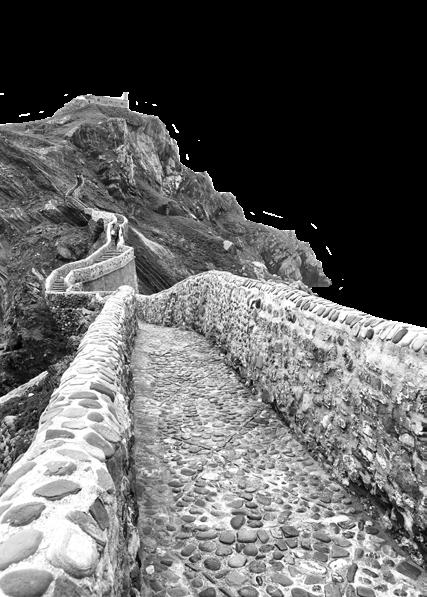


Welcome!




Welcome!

There’s no room for more. Because it’s hard to find so many stunning places so close to one another. The Basque Country is the ideal place to enjoy numerous attractions in a short space of time: varied landscapes, pleasant climate, ancient culture, word-famous cuisine...
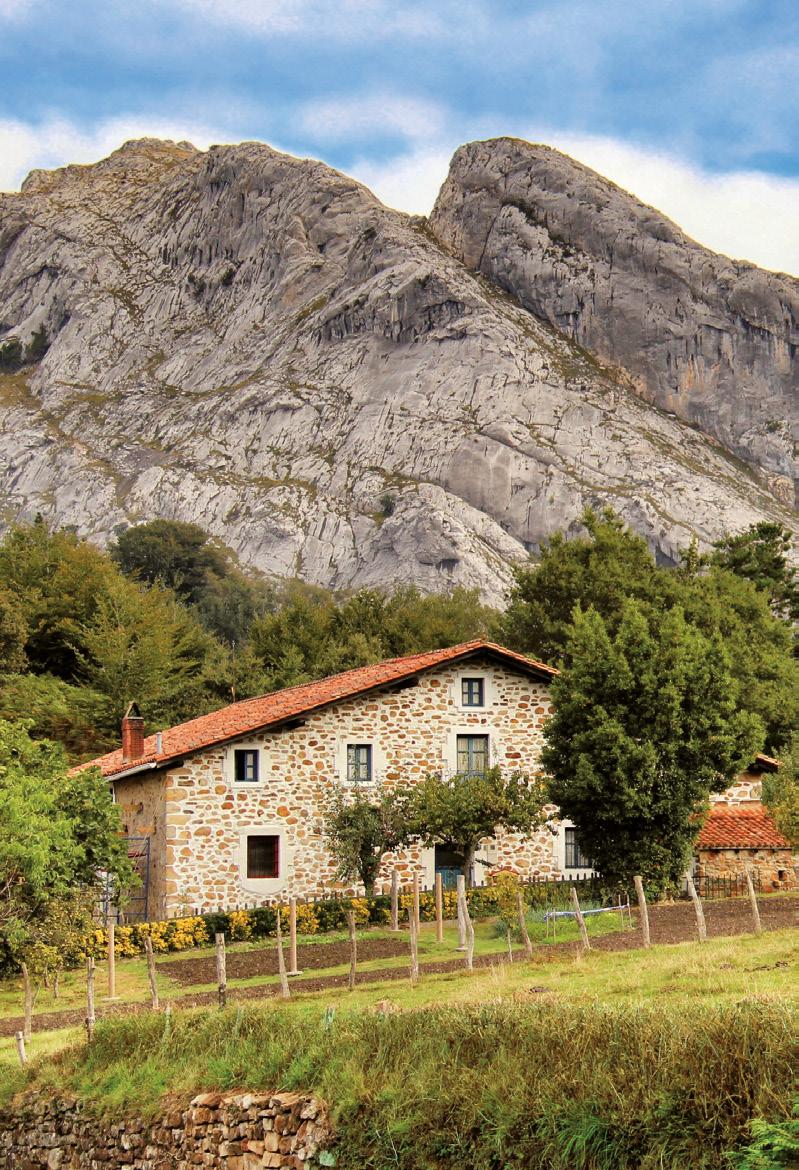
Two colours will accompany you on your journey through the Basque Country: the green of the incomparable setting of its mountains and valleys, and the blue of the sea. You will see that the Basque people have strong links with these natural environments: land and sea. Both have been determining factors in a lifestyle revealed by their idiosyncrasies: deeply rooted customs, a rich culture, traditional sports...
To better understand the nature of these people it is important that you immerse yourself in its traditions, exploring the fishing ports and the life of the countryside... On the coast you will see how the Cantabrian Sea has marked the personality of the neighbouring villages. You will also notice the difference between their inhabitants and the inland people. If you explore the history of the outstanding figures who have marked the personality of these communities you will discover how their maritime, industrial and agricultural character, always diverse and enterprising, has been bred.
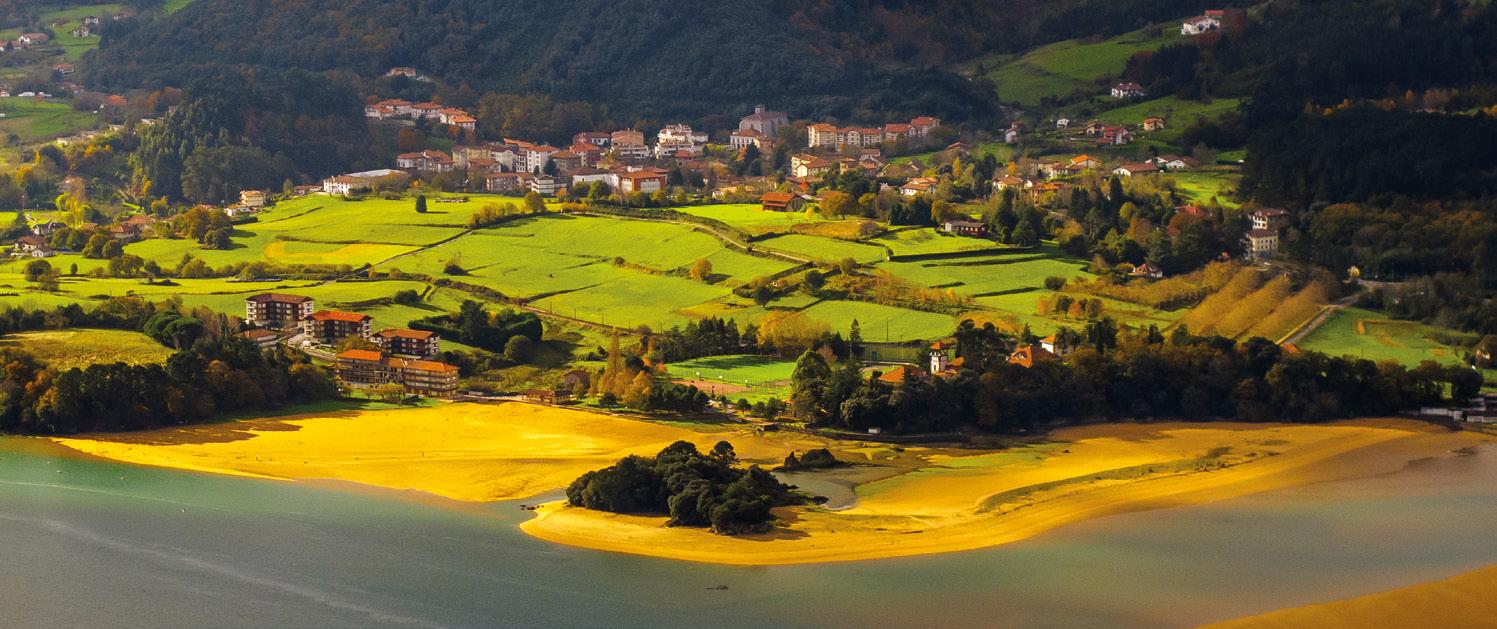
And if you find the coastal and inland villages interesting, you will be no less fascinated by the three capitals. Bilbao will surprise you with its transformation from an industrial city to an avant garde metropolis bringing together the great contemporary international architects. San Sebastian, exquisite and unique, will seduce you with its beautiful and stately setting. Vitoria-Gasteiz will show you its rich heritage and why it sets a worldwide benchmark in urban planning.
Eating and drinking well is an affordable luxury in the Basque Country: local seasonal products in pintxo form with a good wine from the Rioja Alavesa, txakoli or cider. You will be in gourmet paradise! Enjoy!
Experiment, observe, then give way to the passion of taste.
www.turismo.euskadi.eus
The tourism brand which acts as an introduction to the tourism offer in the Basque Country: EUSKADI BASQUE COUNTRY.

Bilbao is the capital of Bizkaia, as well as a metropolis and economic and financial centre of the Basque Country. It is the largest city in the Basque Country (1,000,000 inhabitants) and is a university town.
The Ría (estuary) of Bilbao, the backbone of the metropolis: from the Old Quarter to the Bizkaia Bridge. It is also a city surrounded by small mountains, such as Mount Artxanda, and infrastructures, as for example the cruise port and the main airport in the region and the north of Spain: the international gateway.
Internationally renowned for its urban regeneration, Bilbao won the Nobel Prize for Cities in 2010: “Lee Kuan Yew World City Prize”: “Lee Kuan Yew World city prize”.
- Bizkaia Transporter Bridge, World Heritage Site.
- The City´s Museums: Guggenheim and Fine Arts (now one of the leading paintings and sculpture museums in Spain). The Alhóndiga, The Ethnographic and Basque History Museum, The Reproductions Museum, Athletic Football Club, Bullfighting, etc.
- Its cutting-edge and signature architecture: works by the world´s most famous contemporary
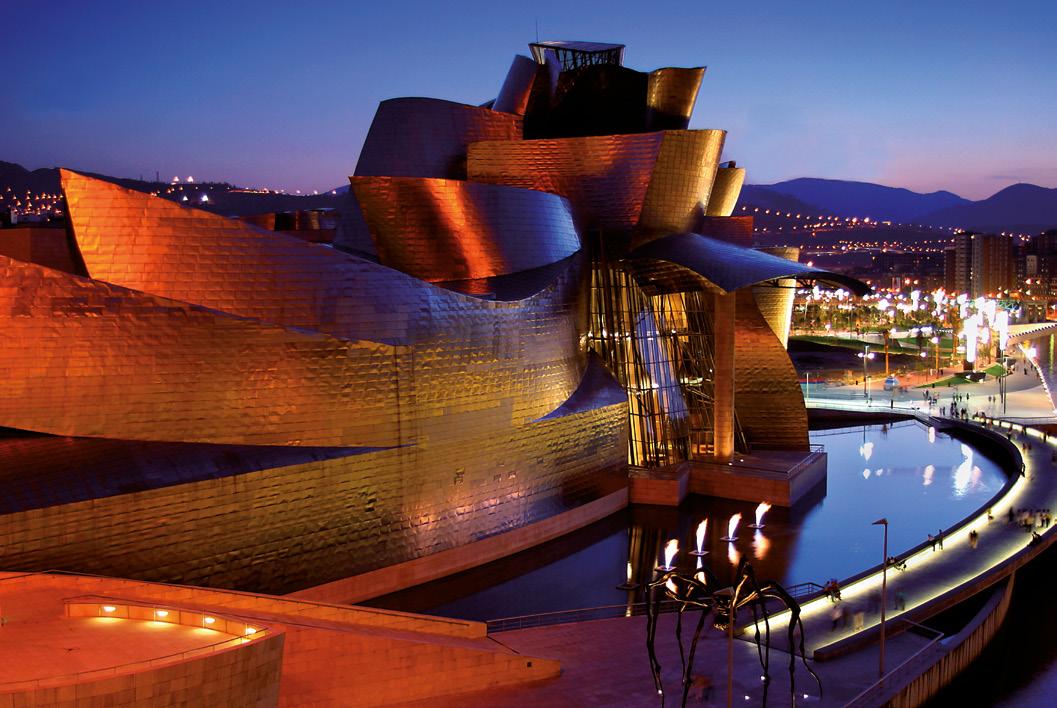
architects (Frank Gehry, Norman Foster, Isozaki, Zaha Hadid and Philippe Starck).
- Take a stroll: through the Old Quarter, and its famous 7 streets, through the Ensanche and up Mount Artxanda, which offers a panoramic view of the city and can be accessed by funicular (cable railway).
- Attend: conferences, trade fairs and meetings (BEC, Euskalduna, Guggenheim, etc.), festivals and cultural events, popular and traditional festivals such as bulls, Semana Grande (week of local festivities), Holy Week, etc.
- Shopping: at leading brand stores, as well as for original products in specialised shops. The Ribera Market is well worth a visit as is the traditional annual Santo Tomás market (21st December).
- Eating-Out: the whole range of Basque gastronomy: from pintxos (similar to Spanish tapas) to haute cuisine, not forgetting the traditional dishes.
- Stay: the best range of accommodation in the Basque Country.
Recommended for being closest to Bilbao are Donostia/San Sebastián, the Basque Coast, the Basque Mountains and Valleys and Rioja Alavesa.
Donostia/San Sebastián is the capital of Gipuzkoa and the major city of the Basque Coast (180,000 inhabitants). A city open to the sea, historically regarded the tourist capital of the Basque Country and is close to France.
It boasts one of the most beautiful bays in the world: La Concha, and three city beaches. San Sebastian is surrounded by mountains and viewpoints: Igeldo, Urgull, Ulia and the Isle of Santa Clara, lie on either side of the River Urumea.
IN SAN SEBASTIÁN, THE FOLLOWING ARE A MUST:
- The Old Quarter, its streets and iconic buildings.
- The romantic area of the city and its buildings with French influences.
- San Telmo Museum and the Aquarium.
- Take a stroll: walks and nature-related activities on foot and/or by bicycle along the promenade from the “Peine de los Vientos” sculptures to the Kursaal, up the urban mountains, their parks and gardens and enjoy the delightful pace of life by the sea or go surfing at its beaches.
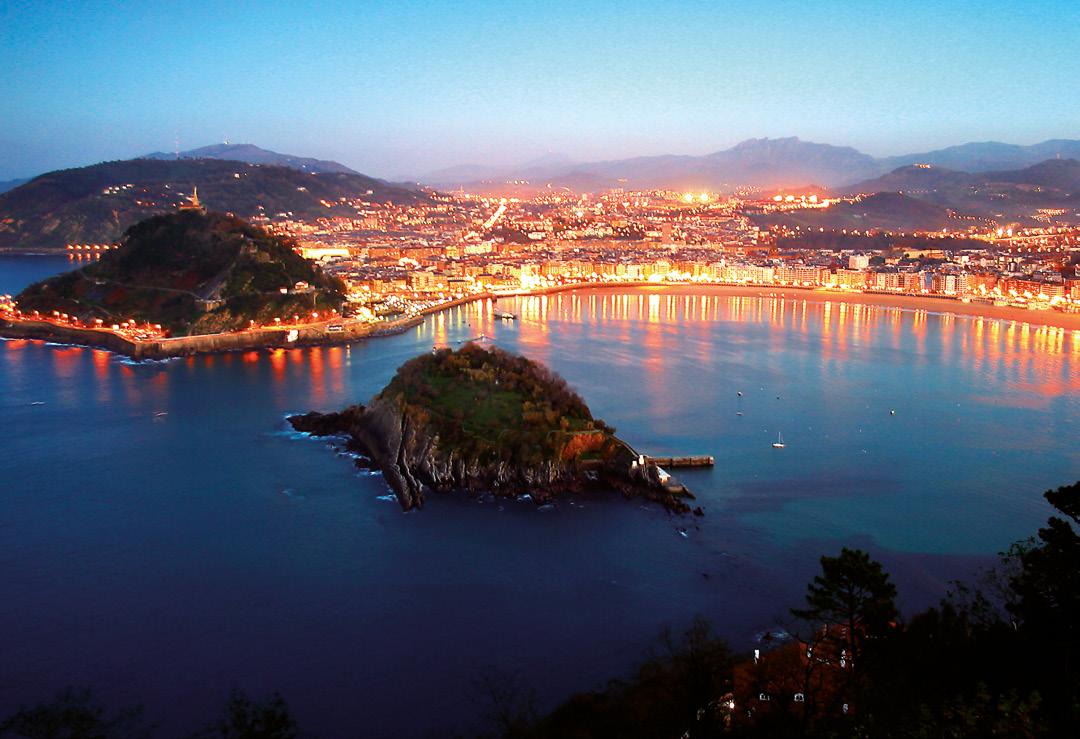
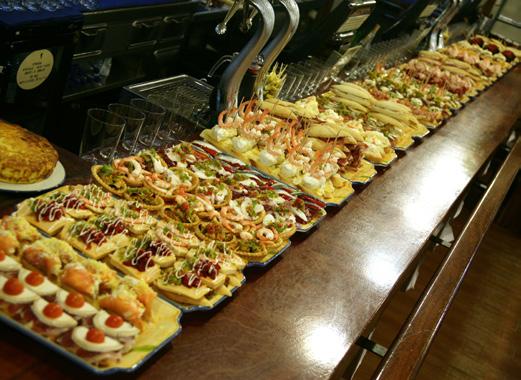
Kursaal Palace, festivals and popular events, such as the Tamborrada (drum procession), Santo Tomás agricultural and gastronomic fair, the International Film Festival, La Concha Pennant, the hippodrome and the casino.
- Shopping: in the Ensanche and the Old Quarter.
- Eating out: the city of gastronomy par excellence: with more Michelin stars per square metre than any other in the world. Go for pintxos in the Old Quarter and other neighbourhoods of the city. Likewise sidrerías or cider houses are also a good choice.
- Accommodation: the city offers a wide range of hotels and some of the most iconic hotels in the Basque Country.
Recommended for being closest to Donostia/San Sebastián, are Bilbao, the Basque Coast, the Basque Mountains and Valleys.
Vitoria-Gasteiz is the capital of Alava, Vitoria is the administrative capital of the Basque Country (250,000 inhabitants). It also boasts the most important logistics centre in the north of Spain and is surrounded by nature.
The historic centre and original almond medieval shape is noteworthy, particularly the cathedral (in this 3 cathedral city) which although undergoing restoration remains open, noteworthy is the modern, well-planned, user-friendly and accessible urban planning, as well as the surrounding green belt. In 2012, it was the “European Green Capital”.
IN VITORIA, THE FOLLOWING ARE A MUST:
- Its old quarter and the so-called medieval “almond”, where the Cathedral of Santa Maria lies and its unique project called “Open for Work”, which inspired Ken Follett in his novel “World Without End”. Visit the 5 towers, the historic streets and the walls in this part of the city.
- Museums: Bibat, Artium, Fine Arts Ajuria Enea: Residence of the President of the Basque Country.
- The new, well-planned urban layout of VitoriaGasteiz.

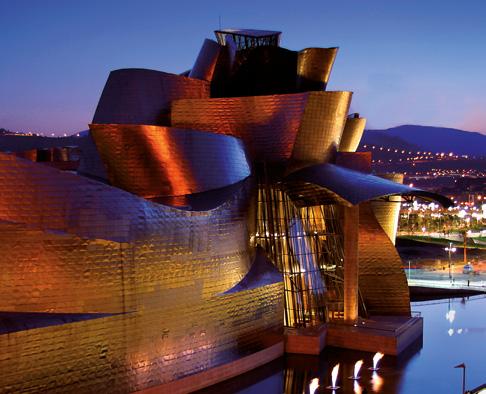
- Take a stroll: through the “green belt”, with pathways, lakes and reservoirs integrated into nature that is full of flora and fauna, through the towns and villages of Vitoria (Estibaliz, Armentia, Foronda, etc.)
- Attend: its renowned jazz festival and local festivities, among which San Prudencio (28th April) and La Blanca (August) are particularly noteworthy.
- Things to do: nature sports (green belt), bird watching (lakes and reservoirs) and visit Ataria, the Interpretation Centre of the Salburua Wetlands.
- Shopping: At its confectioners, mainly in the pedestrian and commercial area and at the medieval “almond” market.
- Eating-Out: its sweets are famous for their quality. The wines and gastronomy of the Rioja Alavesa.
- Accommodation: at its new, fully accessible hotels.
Recommended for being closest to Vitoria-Gasteiz are Rioja Alavesa and the Basque Mountains and Valleys.
The Basque Mountains and Valleys are our natural environment. The quiet Euskadi. They are a reflection of culture and traditions: Gernika and the General Assembly House, beacons, myths and legends of the Basque Country, the farmhouse and the way of life, rural sports.
The 9 natural parks and pilgrimage routes stand out: Camino de Santiago and Camino Ignaciano (St. James’s Way and Ignatian way), and religious cultural heritage in Loiola (house of Ignatius of Loyola, founder of the Society of Jesus) and in Arantzazu, La Antigua, Zenarruza, Estibaliz and Urkiola.
IN THE BASQUE MOUNTAINS AND VALLEYS, THE FOLLOWING ARE A MUST:
- Its villages, rural traditions, lifestyle (30,000 farmhouses), heritage, rural sports, processions, etc.
- Its landscape that has been shaped by man: coalmines, salt mines, mines, foundries, quarries, etc.
- Museums: ecological, industrial, interpretation centres, etc.
- Take a stroll: through the accessible natural environment, through the conservation areas, up the mythical mountains (Gorbea, Anboto, Txindoki, Aizgorri, Ernio), through its valleys and regions, through its forests and rivers.
- Attend: Basque Pelota competitions, rural sports, processions, fairs and markets.
- Things to do: ecotourism activities, such as bird watching and geotourism, or visits to places of high environmental and heritage value. And more active and sporting activities such as hiking and cycling.
- Shopping: traditional gastronomy products (Eusko label), Idiazabal, cider, txakoli, tinned produce. Basque artisan products and ceramics.
- Eating-Out: traditional food (authentic, local products).
- Where to sleep: in rural accommodation and charming hotels, some of them with the ECOLABEL.
From the Basque Mountains and Valleys, visit for example the Basque Coast, Rioja Alavesa, Bilbao, Donostia/ San Sebastián and Vitoria-Gasteiz.
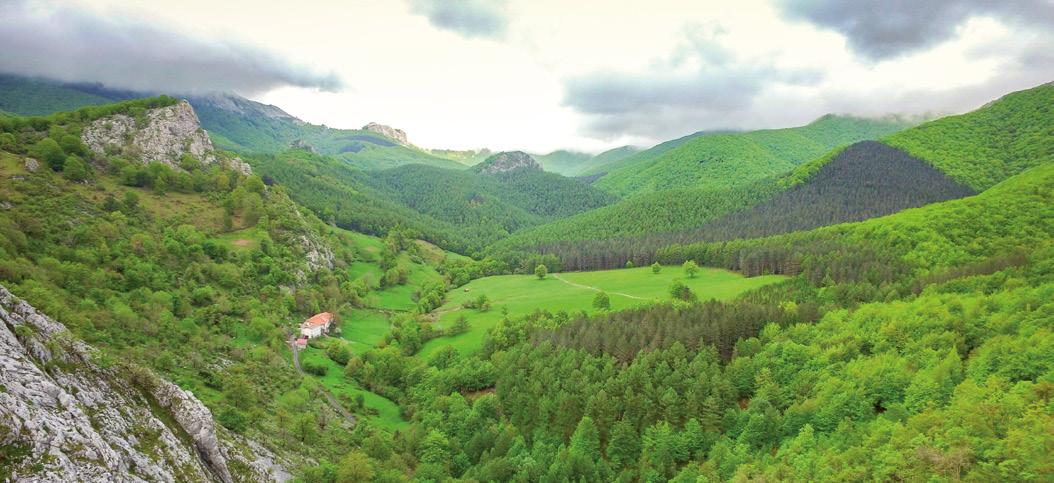
The Basque Coast is very diverse: there are fishing villages and seaside towns, with city beaches and other beaches that will blow you away. Marinas, marshes, estuaries lined by sea cliffs and an active sea.
Among its emblematic towns and areas, Hondarribia, Zarautz, Getxo and Lekeitio, La Concha bay in San Sebastian, San Juan de Gaztelugatxe, the Getaria Mouse, Bilbao and the Bizkaia Bridge, the Urdaibai Biosphere Reserve and the Geopark stand out. The Basque Coast also boasts a rich maritime culture and many illustrious seafarers: Elcano, Cosme Damián de Churruca or Víctor Hugo.
ON THE BASQUE COAST, THE FOLLOWING ARE A MUST:
- Its fishing villages, medieval towns and cosmopolitan cities giving you an insight into the way of life by the sea, based around fishing and the fishing heritage (fish markets, festivities, gastronomy).
- SPAs.
- Its natural corners: conservation areas and wetlands, viewpoints and watchtowers.
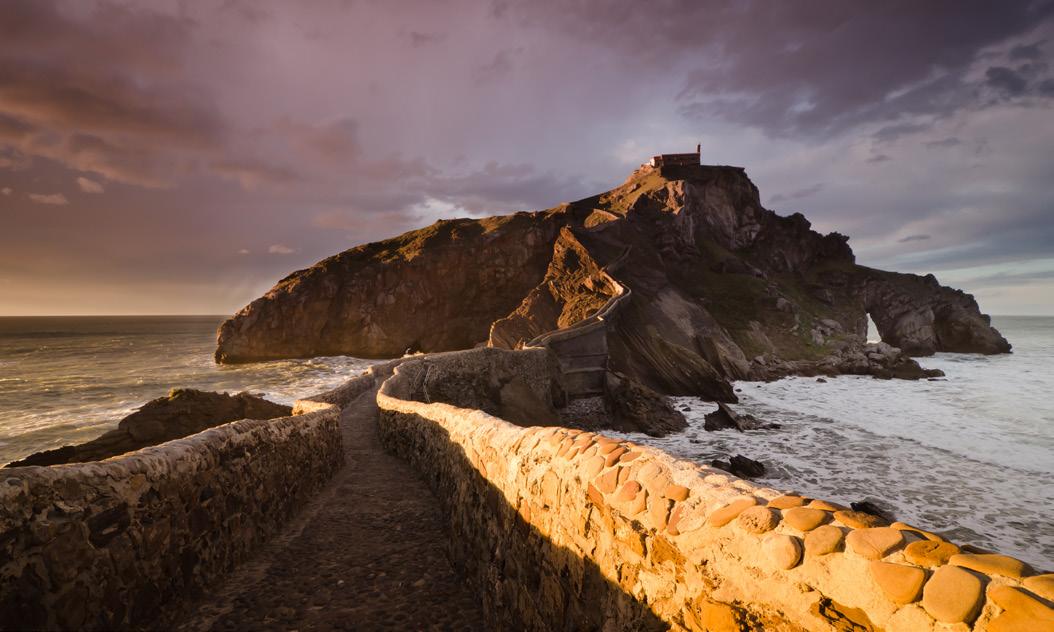
- Its network of museums on the Basque Coast (among others: the Museo Balenciaga in Getaria, the Bilbao Maritime Museum, the Fishermen’s Museum in Bermeo, the Oiasso Roman Museum in Irun, the Albaola Maritime Factory in Pasaia, and the Santa Catalina Lighthouse in Lekeitio, the Aquarium of Donostia,...).
- Walking: On the Basque coast nature´s green sweeps down to the sea: Take a stroll through Urdaibai, the Flysch route, along cliffs, through the painted forest of Oma, visit the wetlands and wild beaches or routes, such as the Camino de Santiago along the coast.
- Attend: sports competitions, some of which are international, such as surfing, sailing and other
unique sports like traineras (rowing boat races). Attend local festivities and fish markets.
- Practice: water sports (surfing, sailing, diving), trekking and activities in nature, bird watching and whale watching.
- Shopping: tinned fish, txakoli.
- Eating-Out: fish paired with txakoli. Excellent gastronomy.
- Accommodation: in charming rural houses, small family run hotels and campsites.
Given how close it is from the Basque Coast visit Bilbao and the Basque Mountains and Valleys.
Rioja Alavesa is a land of ancient vineyards, producing unique wine from its tempranillo Grape. Watered by the river Ebro and surrounded by Sierra of Cantabria, this region boasts the most spectacular wineries: such as Ysios, Baigorri, Riscal, Viñarreal-CVNE, with wine villages and family run wineries as well as a product with structure: Rioja Alavesa Wine Route.
IN RIOJA ALAVESA, THE FOLLOWING ARE A MUST:
- Its villages: Laguardia, Labraza, Elciego, Samaniego, Labastida.
- Its state of the art wineries.
- Its traditional family run wineries.
- The Balcony of Rioja.
- Its thousand year old heritage: the historic town Poblado de La Hoya, dolmens.
- Take a stroll: through vineyards and historic villages.
- Attend: traditional wine events and festivities. Tastings and sampling.
- Activities: trekking, bird watching, cycling, wine therapy.
- Shopping: Rioja Alavesa wines.
- Eating-Out: gastronomy and wine.
- Accommodation: in rural accommodation and at new charming hotels such as Marqués de Riscal.
From Rioja Alavesa because of how close it is, visit the Basque Mountains and Valleys, Vitoria-Gasteiz, Bilbao and Donostia- San Sebastián.
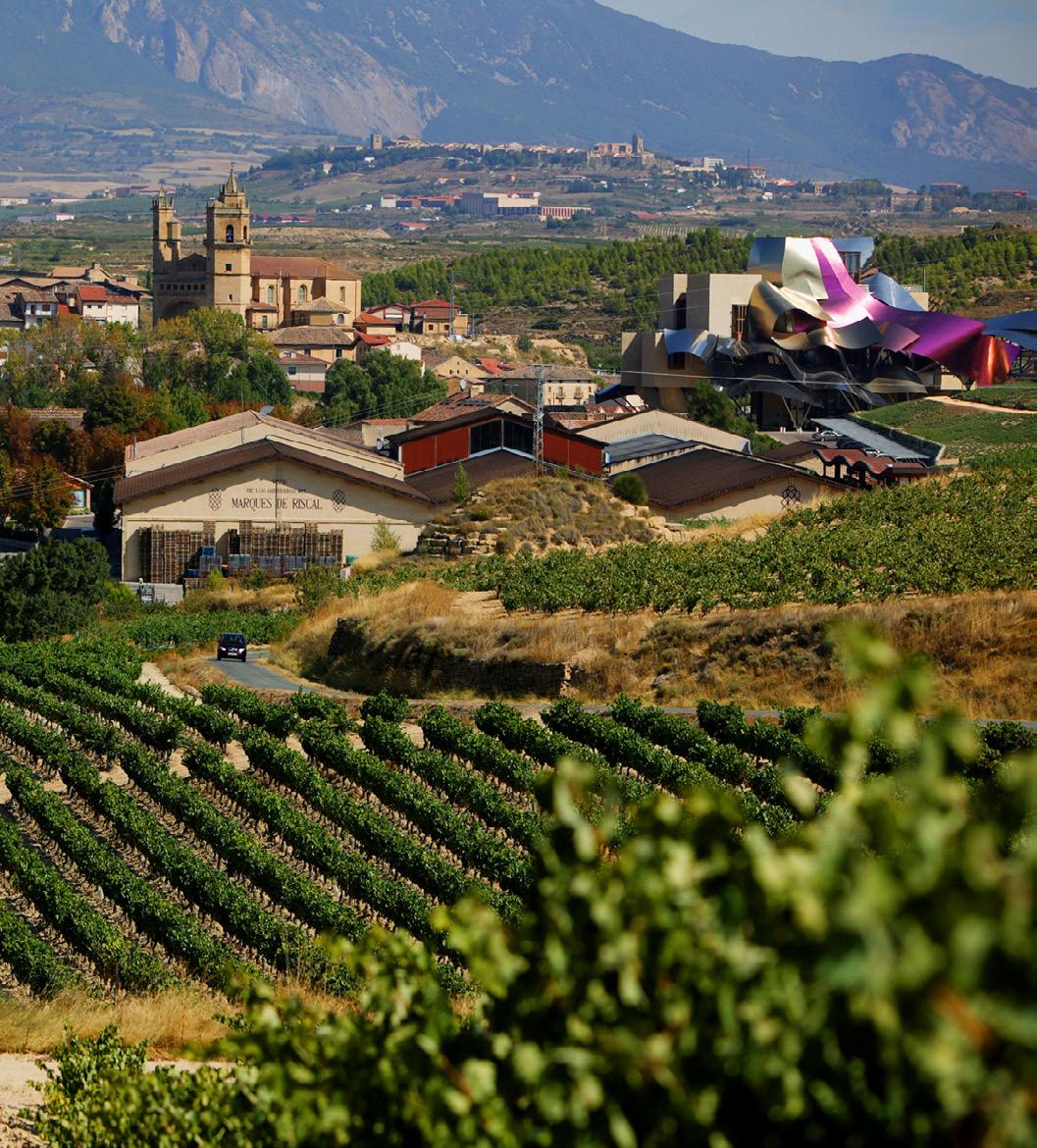
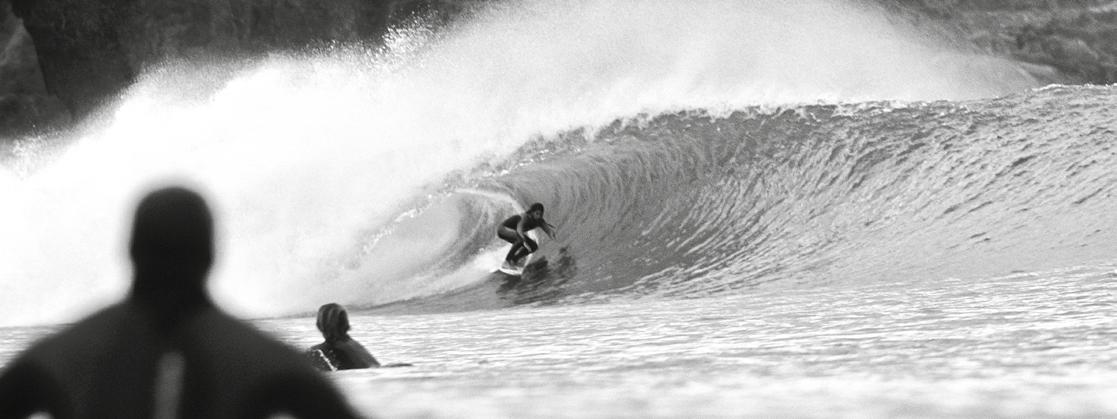
The Basque Country boasts a variety of themed products which compete as a destination; it is a “multiproduct destination”.
Priority Basque tourism products are: touring, Food and wine, culture and MICE.
Likewise city breaks, nature and coast are considered to be top priority. Products that complete the diversity of the offer, both in terms of the landscape and the experiences Euskadi provides.

The main product line is touring. This product aims to take the potential tourist through the region and is based on a series of three proposed routes through the Basque Country and its brands: one of 4 days for long weekends and short trips, and another two of 7 and 15 days for longer trips.
Gastronomy and Wine is an important product line in the Basque Country as it is one of the most identifying elements of its image and positioning, thanks to the quality of what is on offer and the power of its legendary product brands and authors. The main product is the Rioja Alavesa wine, but there are a number of other proposals in the form of routes, such as txakoli, cider houses, pintxos, signature restaurants, etc. The main brands in this offer are the Rioja Alavesa and San Sebastián brands, however because of the cross-reality throughout Euskadi other brands are also present.

The Club Euskadi Gastronomika, a network made up of restaurants, bars, shops, and other gastronomic establishments and committed to quality.
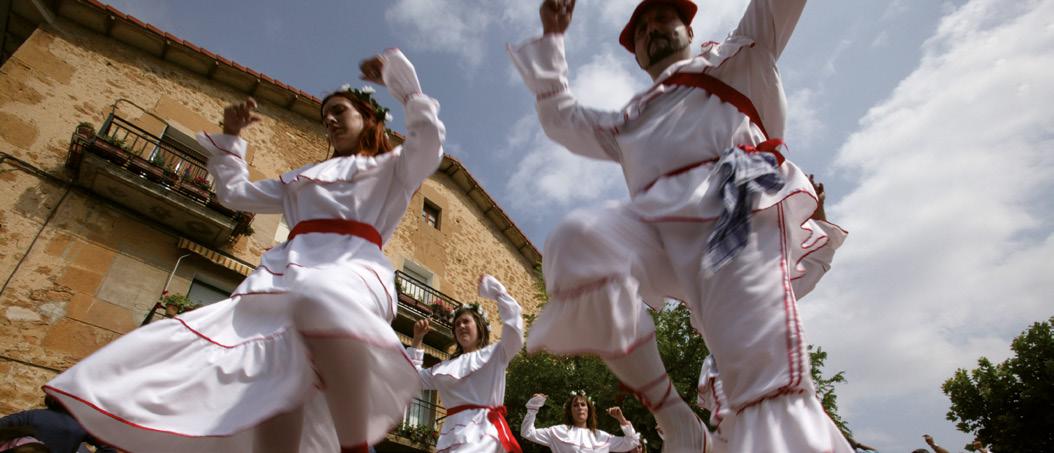
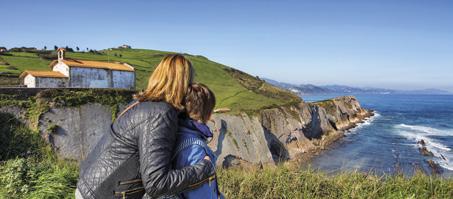
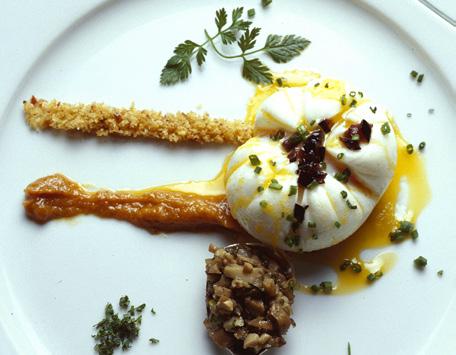
The Cultural Tourism line is therefore influenced heavily by the main reason for the visit, the cultural life of the Basque Country and is therefore a selection of the cultural products (heritage, museums, gastronomy and cultural events) of the 6 tourist brands described. General proposals are made on the culture of the Basque Country and customized proposals for groups of culture-orientated tourists with more specific interests.
The meetings product line, which includes the set of products for Conferences, Meetings, Conventions and Incentives, is the most important product for business tourism. It is closely linked to major user facilities, such as conference centres and other unique spaces and to the specific offers of hotels and specialized organisations. It is therefore linked to the brands of the three cities, which already have specific development organisations, the Convention Bureaux, with programmes focused on this target public.
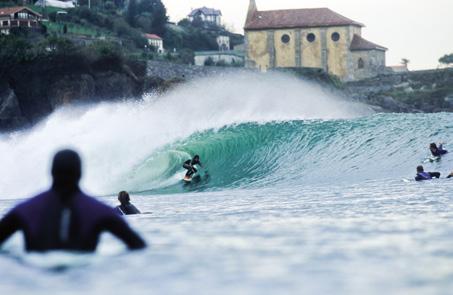
The City breaks product line focuses on the offer of the major capitals of the Basque Country and is structured on the basis of what we call the “four Cs”of city tourism: Culture, Shopping, Food and Character (associated values) of the Bilbao, Donostia/ San Sebastian and Vitoria brands.
The Rural Tourism line is defined mainly by accommodation and carrying out relaxing or active activities in the rural natural area, which often represents a change from everyday city life to a different environment. The Basque Mountains and Valleys brand, by its own conception, is the main product, which is complemented with other rural accommodation options on the Basque Coast and in Rioja alavesa. It must be taken into account that tourists with an extremely focused and specialised level of activity, such as MTB, surfing, etc. are not included in this line, but in the group of niche markets, as the target population is much lower with highly specialised information Land promotion channels.
The Coast Tourism product line focuses on summer tourism, proposing holidays on the Basque coast: from Bilbao to San Sebastian, more than 200 scenic kilometres to visit the most emblematic places in the Basque Country, and enjoy the classic sun and sea activities, as well as other complementary ones. Beaches, surf, estuaries, marshes, cliffs. Lighthouses. Villages with a seafaring soul, whalers and sailors, net menders and fishermen, rugged in character, with a brilliantly blue living sea. Given their proximity to this brand, visits to Bilbao and Basque Mountains and Valleys are also proposed.

The Club Surfing Euskadi brings together over 70 agents capable of creating a global and individualized product based on quality, experience, and professionalism: surf schools, surf camps, specialised accommodation, guides, receptions, shops...
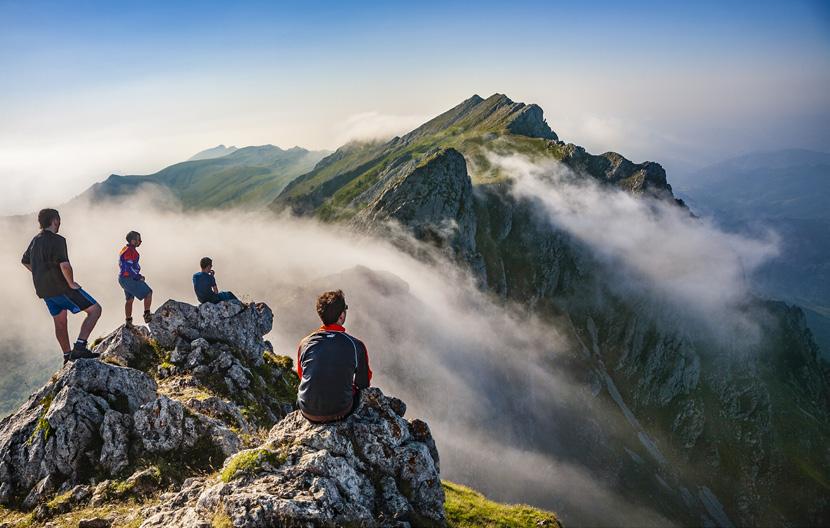
Product categories adapted to specific niche interests: Religious tourism (linked to the Camino de Santiago and Camino Ignaciano), active nature tourism (mountain biking, hiking, following the “vías verdes” or “green ways”, either on foot or by bicycle, surfing), ecotourism (bird watching), and industrial tourism (mines, steelworks, forges, armouries, shipyards, beret and playing card factories, etc.).
Family tourism stands out as the second most important segment in Euskadi with activities and experiences for children both in the cities and on the coast and/or inland: educational activities, surf activities, staying in tree houses, bread workshops, talo (Basque arepa) workshops, chocolate workshops, being a beekeeper or a shepherd for a day...
The Basque Country also offers a wide range of TOP tourism experiences which are appealing to the tourist. These activities with complementary elements that add value and make them unforgettable. Top 10 Euskadi experiences, those which must not be missed on your visit are:
1 - A pinch of salt in the Salado Valley: The landscape of the Valle Salado de Añana is one of a kind given it architectural uniqueness and its three thousand years of history. This experience will allow you to learn the secrets of the Salt from Añana from different aspects: historical-cultural, natural, productive, therapeutic and, of course, culinary. Gourmet salt from the Salado Valley has attracted the most renowned Basque chefs, who have added it to a very unique menu that awaits you. Enjoy!
2 - Shepherd for a day: In one of the most impressive mountain backdrops of the Basque Country, the Urkiola Natural Park, and the Alluitz Natura SL facilities can be found alongside the Atxarte cheese creamery, where Shepherd Patxi Solana invites us to share his daily chores.
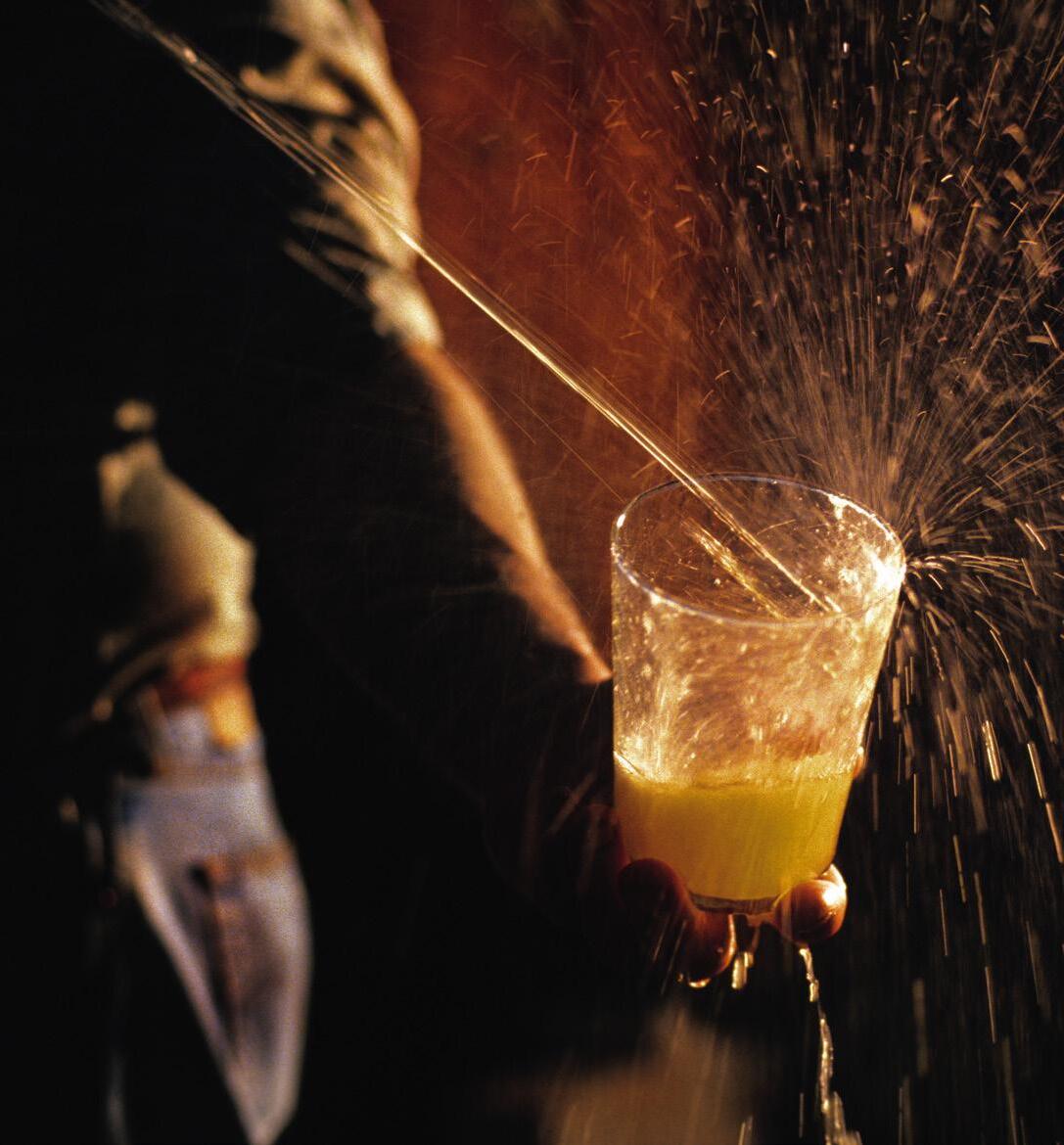
3 - Cider and sea: The tradition of cider and the txotx! ritual have become a social phenomenon in the Basque Country, which attracts thousands of visitors. Cider houses have adapted their facilities to cater for large groups who enjoy this tradition together. There are however some farm house who continue to elaborate cider and offer a more personal experience to small groups.
4 -The Flysch Route. Geopark on the Basque Coast: Pure and simple nature, are the towering cliffs of Mutriku, Deba and Zumaia, enigmatic rocks when contemplated from the sea. The geological formation known as flysch is an open book where millions of years are written in stone. In every village and at every point, both by boat and on foot, discover the secret history of the Earth at the edge of the sea.
5 - Aroma and Landscapes of Rioja Alavesa: Where medieval villages ressemble islands in a sea of endless vineyards, where wine and culture are synonymous; only there you can taste wines that will captivate your palate. Rioja Alavesa awaits. At each winery, the winemakers will show you the secrets of winemaking. This is where the wine is born and grows, this is where they know best.
6 - The gripping tale of an ancient wine: Txakoli, the white wine par excellence from the Basque Country, acquiring a standard of excellence in the Azurmendi wine and gastronomy complex. Located in a beautiful corner of the province of Bizkaia, Larrabetzu, this space of architectural contrasts combines the best of the world in avant-garde cuisine with txakoli wine and culture. Led by Eneko Atxa, the renowned chef of Azurmendi the award winning Michelin 3-star Restaurant. Numerous options are available at this place and are open to you.

7 - Basque rural sports: The Basque people have made their free time, in many cases, an extension of their work. Traditional games in the farming villages and rural sports are good examples of this. The wealth of games is impressive, the best known being, probably, pelota, lifting stones, cutting logs and sokatira (pulling the rope). Learn about the world of Basque rural sports first hand, and have a go at playing one of them accompanied by athletes preparing for national and international champions in the various sports. Choose the sport that most appeals, have fun and play. An experience that will not leave you indifferent.
8 - Navigating up the Urdaibai estuary: The one and only Urdaibai estuary. Its natural wealth, its scenery, historical heritage, traditions, etc., have earned it universal recognition and UNESCO has declared the Urdaibai estuary a Biosphere Reserve. This experience gives you the opportunity to get to know this beautiful enclave right from its heart; from its inland waters aboard a comfortable boat. A unique way to enjoy the landscape beyond a mere boat ride. And the experience is accompanied by a guide / story teller to envelop you in a world of legends and knowledge. The trip includes docking time for a delicious local aperitif, accompanied by a traditional Basque music session for you to enjoy.
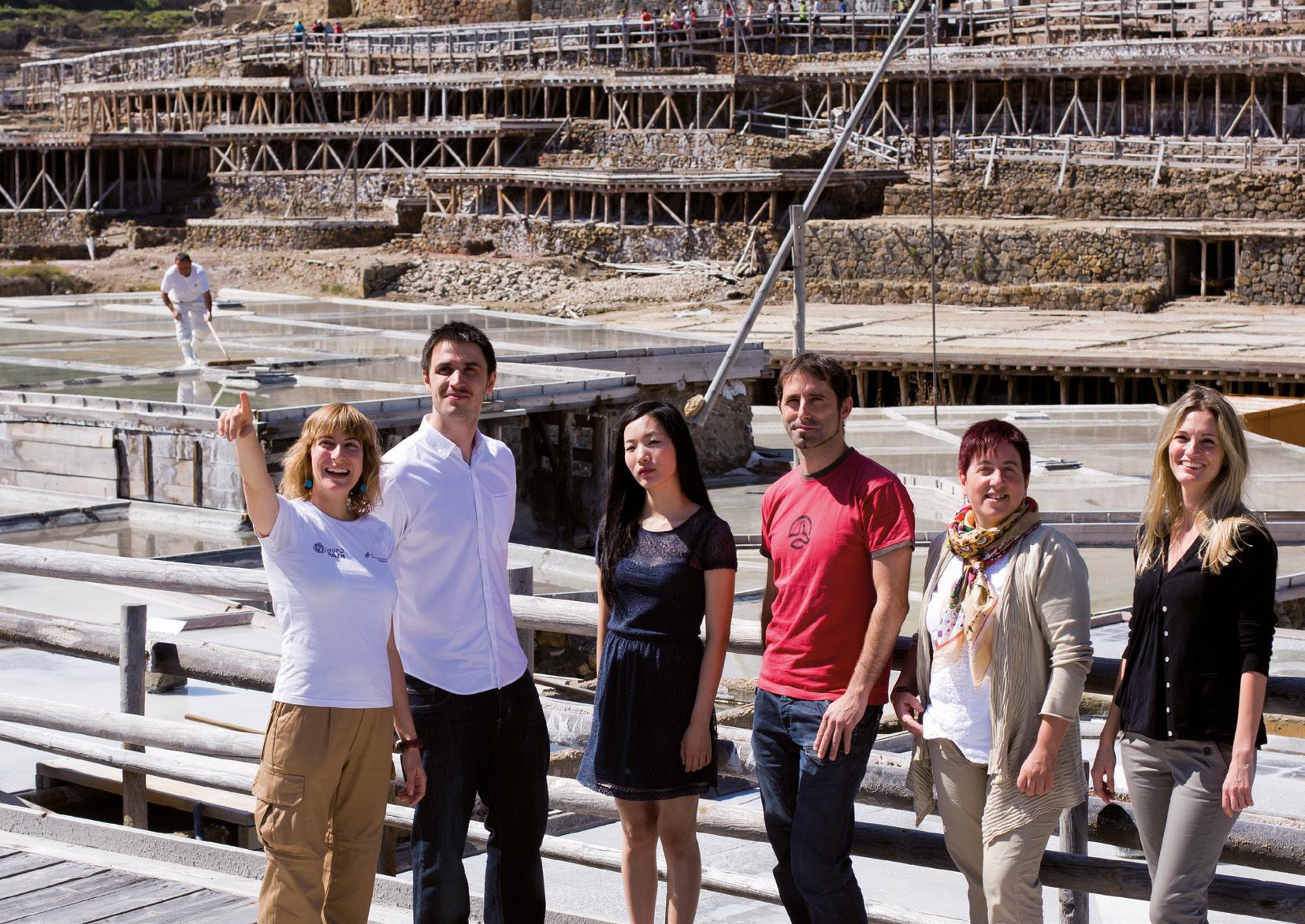
9 - The Basque pelota and the sea: To enjoy and play the ball game in the beautiful hundred-year old court in Bermeo, a fishing village on the Basque Coast. The Basque ball game par excellence, was the “safety valve” for arrantzaleak (fishermen in Basque) during their leisure time.
10 - A cooking course at the gastronomic society of San Sebastián: The recognition of the Basque cuisine relies heavily on the authenticity of the raw materials used to elaborate the different dishes that have made Basque cuisine world famous. Fresh, natural, seasonal and premium quality and quite often only found in very specific places. The La Bretxa market in Donostia/San Sebastián is one of those essential places to buy fresh and seasonal products. This experience invites you to visit different places, talk to the growers and buy the best products to create a complete traditional Basque menu. A menu, in the company of friends or family, you will learn to elaborate it under the orders of a chef in a very special place in the Old Town of Donostia/San Sebastián; in a real Gastronomic Club.
The mecca of San Sebastian cuisine open exclusively for you and yours. Pleasant, fun cooking and moreover, you get to enjoy the food later. Bon appetite!
Further information on tourist experiences in the Basque Country at: www.euskaditurismo.eus and at: www.viajesporeuskadi.es
A resource is considered to be top when its potential value is so high that it is able to attract a wider public. The greater the potential value, the greater the ability to attract. The TOP resources make up the main tourism offer in the Basque Country, and their appeal capacity will enable them to act as interest driving forces for an “experienced” public to discover the Basque Country.
1 - The Gernika Tree and the General Assembly House. The headquarters of the highest institutional body in Bizkaia, the Gernika General Assembly House is alongside the mythical Tree, the symbol of all the Basques and is the site where councillors of the dominion of Bizkaia have assembled since the Middle Ages. The Gernika Tree is the heart of the architecture of the General Assemblies of Bizkaia. In the past, the most important civil ceremonies were held under the shade of the tree and it is where the Lord of Bizkaia swore to respect the Basque fueros (set of rules of public and private law). A survivor of the Gernika bombing, this oak tree has become the symbol of the Basque People. The current tree

was planted in 2004 as a result of the death of the previous one, which dated back to 1860, at the hands of the Armillaria mellea fungus, which in turn had replaced the original “old tree” which was over 300 years old. Many shoots of this tree are found around the world in the different cities of the Basque Diaspora.
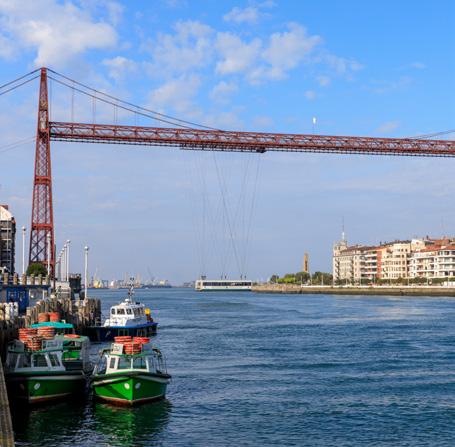
2 - The first World Heritage Site that UNESCO granted the Basque Country in 2006, is the transporter Bridge or Bizkaia Bridge, between Portugalete and Getxo. This work, representative of iron architecture which arose from the Industrial Revolution and which is 120 years old, was the first construction of these characteristics in the world and served as a model to many similar bridges in Europe, Africa and America. It is undoubtedly the most international work of its designer, Alberto de Palacio and Elissague and the UNESCO highlighted the innovative use of lightweight, twisted steel cables. Located at the mouth of the River Ibaizabal (or Bilbao River), it is a transporter bridge that was conceived, designed and built by private initiative between 1887 and 1893 to link Portugalete and Getxo.
3 - The Hermitage of San Juan of Gaztelugatze: is one of those special places that once you have seen it, you know it will be difficult to forget. Torn between the vastness of the Cantabrian Sea and the solemnity of the cliffs of the Basque Coast, Gaztelugatxe islet is surrounded by an atmosphere
of mysticism and magic that permeates all who visit. Although from the mainland it is possible to contemplate its unparalleled beauty, the view from the sea is unmatched. Joined to the mainland by a bridge and more than 200 steps, it is crowned by a hermitage dedicated to St. John, whom the local fishermen render deep devotion, and to which different rites and legends are also associated. In these waters, once navigated by corsairs and pirates the important naval battles in our history have taken place.
4 - Urdaibai Biosphere Reserve: a haven nestled in the Bay of Biscay, the Urdaibai Biosphere Reserve (23,000 Ha) is located in the Busturialdea townland in Bizkaia. From the cliffs and beaches to the forests and rivers of the interior, including the marshes and river valleys, Urdaibai holds probably the greatest landscape and ecological diversity in the Basque Country.
5 - The estuary of Mundaka is the centre of this exceptional enclave declared a Biosphere Reserve by UNESCO in 1984. The 12 km of extensive sandbanks forming the estuary at its mouth, where fresh and salt water mix, are the most important wetland in Euskadi. In addition, the environment is of great international interest as it is the resting and wintering place for many species of rare migratory birds in the Iberian Peninsula including herons, cormorants, terns, spoonbill and a large number of waders, which are birds that feed on animals that live buried or halfburied in the mud and sand.

6 - Balenciaga Museum: The selection of workshops offered by the Balenciaga Museum, located in the beautiful town of Getaria on the Basque Coast, shows the legacy of the most universal Basque fashion designer, defined by Coco Chanel as “the only one of us who is a true couturier “.
7 - Donostia/San Sebastián: is undoubtedly the tourist destination with the longest history in the Basque Country. It was frequented by the European aristocracy during the “Belle Epoque”, which the poet, Gabriel Celaya defined as an “open city and simply human. This city, which was always wanted without walls and which accepts all, and is beautiful for nothing”. For many, it is one of the most beautiful cities in the world, with its balanced combination of small mountains, mansions and sea... and La Concha Bay, around which the city lies, a cosmopolitan city where the laid-back pace of living by the sea is savoured. Its gastronomy and intense cultural life are another of the attractions that make Donostia/ San Sebastian an essential place to visit for all travellers who enjoy fine dining and the cultural events of importance, including the International Film Festival.
8 - Geopark of the Basque Coast: The Basque Coast Geopark is a small area wedged between the Cantabrian Sea and the Basque mountains, comprising the municipalities of Zumaia, Deba and Mutriku. Coast Geopark is a small area wedged between the Cantabrian Sea and the Basque mountains, comprising the municipalities of Zumaia, Deba and Mutriku. The real interest of this place is in its 13 kilometres of cliffs of the Geopark whose spectacular rock formation called flysch layers which, like a great encyclopaedia, depict over 60 million years of the history of Earth. Geologists and visitors can walk along these cliffs or take a boat tour and travel through time to discover, for example, the thin black colour that highlights the impact of a large asteroid and the great dinosaur extinction approximately 65 Million years ago.

9 - Ignacianan Country (Loiola, Aranzazu, La Antigua): This cultural and historical route takes us into the heart of the Basque Country and allows us to travel to the XVI century to experience firsthand the pilgrimage of San Ignacio de Loyola. A unique opportunity to discover Basque sacred
art through its three landmark buildings, whose architectural uniqueness is admired worldwide, as well as to find villages full of history and heritage.
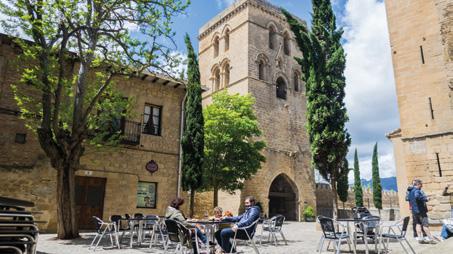
10 - Laguardia: Monumental site and wine capital, Laguardia is synonymous with good wine and its culture is present in the vineyards and at the wineries and restaurants in the area.. It is one of the compulsory stops of the famous wine route; most wineries are visited and explain step by step the development of their valued wines, plus offer tastings. This town is also widely regarded for it monumental historical ensemble. Located on a hill, its medieval layout remains intact. The walled nature of the village has enabled the wine capital of Laguardia-Rioja Alavesa to provide a pedestrian town where it is a delight to walk. It has two fortified churches, San Juan and Santa María de los Reyes, as well as numerous ancestral and palatial homes.
11 - Bilbao is proof that, as the film director, Stanley Kubrick, said “no dream is ever just a dream”. One day, the city of Bilbao decided that it needed to reinvent itself and rise from its ashes, and it was transformed into what it is today: a modern, cult
and stimulating city which competes with the leading European capitals in everything it puts its mind to. Bilbao is more than the Guggenheim, an icon which it does not renounce and which put it on the tourist map worldwide. Today, Bilbao is quality of life and culture, gastronomy and art, international quality shopping and accommodation, business and meetings, and an international airport into which airlines from all over the world operate. However, Bilbao is also friendly people, strolls along the river, fun and nightlife. In short, it is a city that is increasingly attractive to visitors.
12 - The name of Bilbao is already inextricably linked to the Guggenheim Museum. Now, 26 years after its opening, the building continues to be an unquestionable attraction and the city’s most famous icon. The boldness of Bilbao in becoming the first city in Spain to have a museum sponsored
by the Solomon R. Guggenheim Foundation, and the audacity of dreaming of a project by Frank O. Gehry, speak volumes of the strength and courage of the Basque people and their ability to transform the future of Bilbao. When the success of the museum is already a consolidated fact, its appeal capacity should also act as a call to show the potential tourist that the museum is no more than the tip of the iceberg of the city of Bilbao’s vast tourist and cultural offer.
13 - Vitoria-Gasteiz: Basque capital, seat of government and the Basque Parliament, is a city that combines natural areas with a rich architectural heritage. Its people proudly boast of living in one of the most comfortable cities with the best services in Europe. “The European Green Capital 2012” is a city to enjoy. It stands out in the European ranking of the highest number of square meters per inhabitant. Moreover, its “medieval
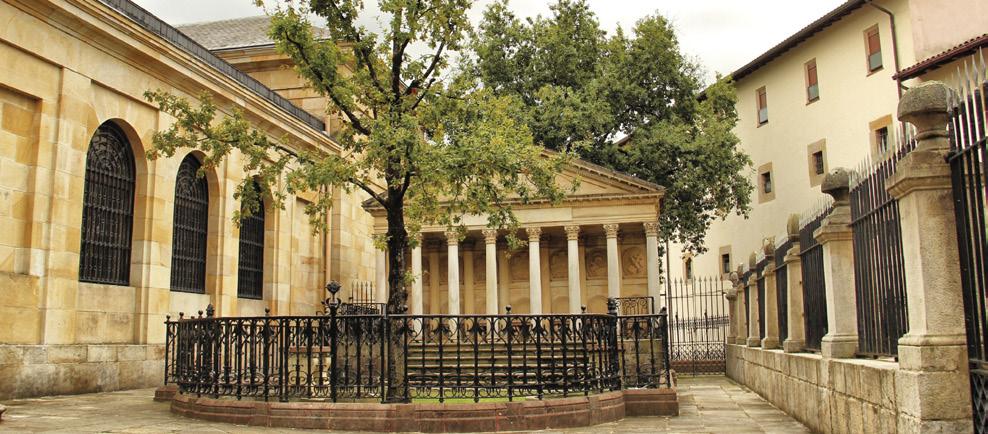
almond” so named for its oval contour, is one of the most emblematic historic centres in Euskadi. The Cathedral of Santa Maria, walls, palaces, coaching inns, etc. Novelists the like of Ken Follett are captivated by the activity generated here.
14 - The owners like to describe the facilities of the wineries of the heirs of the Marqués de Riscal like a “21st century chateau”. This Wine City consists of the former 19th century winery, the oldest in Rioja, and the new building designed by the Canadian architect, Frank O. Gehry, which houses a hotel, a winetherapy spa, an exclusive restaurant, as well as a conference and convention centre. Like the Guggenheim Museum, the building designed by Gehry is covered in titanium, although, in this case, the architect wanted to fill his work with the Marqués de Riscal colours: pink, like red wine, gold, like the mesh of the bottles of Riscal and silver, like the bottle capsule To get Gehry to accept, the proposal was presented accompanied by a wine from the year of his birth (1929), and he gladly accepted.
15 - Hondarribia: Hondarribia has historical treasures that give this town in the Basque Country a special charm. Its walled old town, its cobbled streets full of noble houses and unique buildings such as the Castle of Emperor Charles V, used today as a hotel, the picturesque village of La Marina with its colourful fishermen’s houses, restaurants and typical pintxos bars and terraces... All these features make Hondarribia an ideal destination for a holiday.
16 - Salado Valley- Añana salt flats: The landscape of the Valle Salado de Añana is one of a kind given it architectural uniqueness and its three thousand years of history. Here several types of high quality salt have been produced over centuries, using a system of terraced ponds and channels along a valley that has become one of the most spectacular landscapes in the Basque Country.
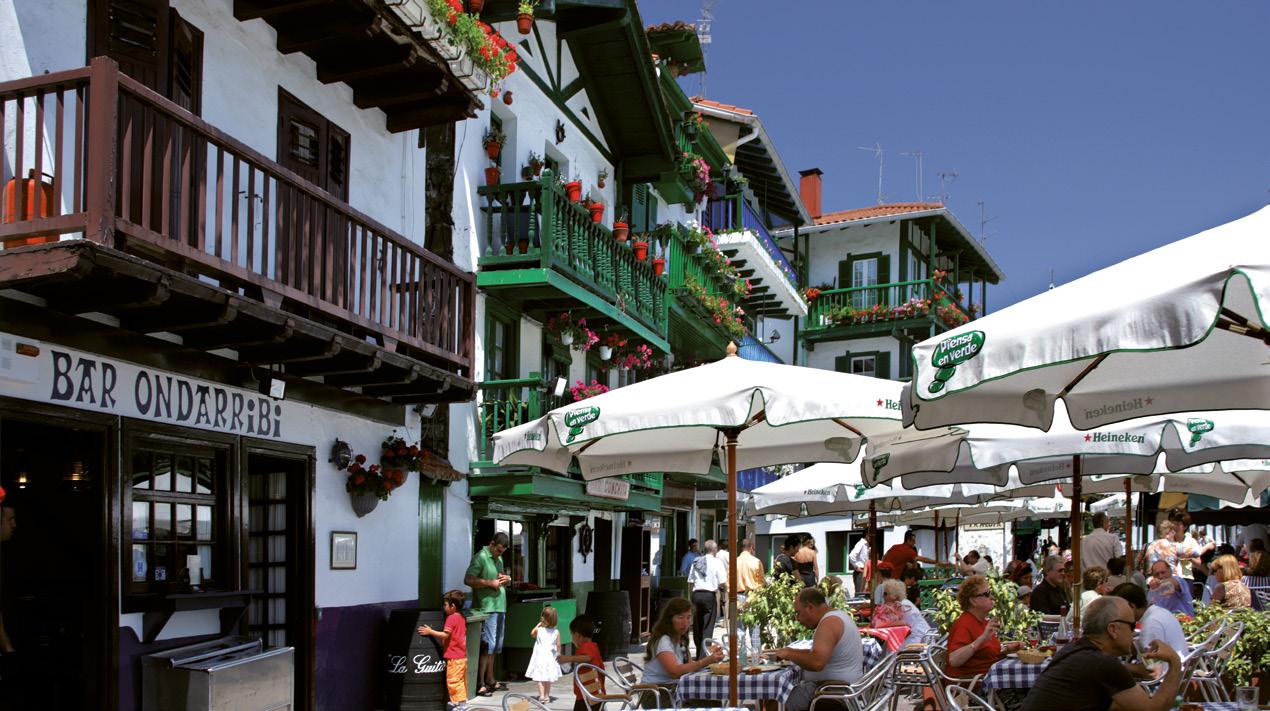

Basque Fest. 16-19 April.
During Easter, Bilbao comes alive with the rhythm of the Basque Fest, the leading festival of Basque culture and avant-garde creativity. The city is filled with cultural and artistic events, transforming Bilbao into a vibrant hub of leisure activities and a culinary paradise.
It’s a unique opportunity to immerse yourself in Basque culture and enjoy an unbeatable atmosphere in every corner of the city. www.bilbaoturismo.net
Semana Grande (Aste Nagusia). 16-24 August. For one week, the city becomes a hub of fun and engaging activities for all tastes.
www.bilbaoturismo.net
Santo Tomás Fair. 21 December.
A popular agricultural market showcasing the best local products, attracting thousands of people throughout the day. A festive and shopping-filled event held every 21 December. www.bilbaoturismo.net
Guggenheim Museum Bilbao.
In addition to the spectacular building and its pleasant surroundings, the museum offers 11,000 m² of captivating and thought-provoking exhibitions. www.guggenheim-bilbao.eus

Bilbao Fine Arts Museum.
The museum’s collection, inaugurated in 1914, features over seven thousand pieces, spanning from the 12th century to the present day. It boasts the most significant collection of works by Basque artists.
www.bilbaomuseoa.eus
Throughout the year, Bilbao hosts numerous sporting events, with the following standing out in 2025:
10K Internacional de Bilbao Rural Kutxa. 9 March. www.10kbilbao.com
Bilbao Menditrail. 6 April. www.laboralkutxabilbaomenditrail.com
Bilbao Jai-Alai Iron Cup. 2 May - 6 June. www.bizkaia.eus/es/kirolbidepro
UEFA Europa League Final. 21 May. www.uefa.com
Bilbao Triathlon. 28 June. www.bilbaotriathlon.com
La Vuelta. 3 September. www.lavuelta.es
Total Energies Bilbao Night Run. 18 October. www.totalenergiesbilbaonightrun.com
Bilbao EXTREME. July. www.bilbaogazte.bilbao.eus
Bilbao Blues Festival. 25-27 July.
‘Bilbao Blues Festival’ will take place in July, featuring over twenty concerts and other free activities. www.bilbaobluesfestival.com
BBK Bilbao Music Legends. 13-14 June. www.musiclegendsfestival.com
BILBAO BBK LIVE. 10-12 July.
Bilbao BBK Live is a major rock and pop music festival held annually in Bilbao. www.bilbaobbklive.com
…NEAR BILBAO
Getxo Jazz Festival. 2-6 July.
One of Europe’s most important jazz festivals, held in late June and early July across various venues in the coastal city of Getxo.
www.getxo-kultura.eus
Getxo Folk. 10-12 September. www.getxo.eus
Gran Bilbao. Santurce-Bilbao. 25 November.
Tamborrada. 20 January.
The city’s biggest festival begins at midnight on 19 January and continues throughout 20 January. Over 100 drumming groups take to the streets to celebrate.
www.sansebastianturismoa.eus
Jazzaldia. 22-27 July.
One of Europe’s most important jazz festivals, held in July. www.jazzaldia.eus
UPV Summer Courses. June - September. www.ehu.eus
Zinemaldia. International Film Festival. 19-27 September.
For one week in September, San Sebastián becomes the capital of glamour. The best films, exhibitions, and the perfect opportunity to share the spotlight with international film stars. www.sansebastianfestival.com
Santo Tomás Fair. 21 December.
A popular agricultural market showcasing the best local products, attracting thousands of people throughout the day. A festive and shopping-filled event held every 21 December. www.sansebastianturismoa.eus
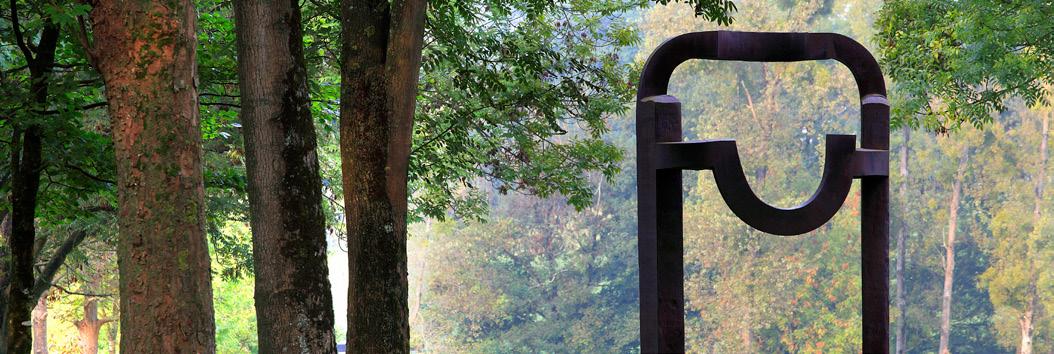
Semana Grande. 9-16 August.
For one week, the city becomes a hub of fun and engaging activities for all tastes.
www.sansebastianturismoa.eus
Chillida Leku Museum.
Comprising over 40 outdoor sculptures and an exhibition space located in the 16th-century Zabalaga farmhouse.
www.museochillidaleku.com
Euskal Jaiak Donostia. 3-14 September. www.sansebastianturismoa.eus
La Concha Flag Regatta. 7 and 14 September.
A weekly competition featuring the most important regattas in the country.
www.sansebastianturismoa.eus
Zurich San Sebastián Marathon. 23 November. The second oldest marathon in the country and one of the most popular and prestigious in Europe. It features a completely urban, flat, and sea-level route. www.zurichmaratonsansebastian.com
Behobia- San Sebastián Race. 9 November. Behobia-San Sebastián is more than just a race. It’s a feeling, built over more than 100 years through the effort, emotions, and enthusiasm of thousands of athletes and the warm welcome of a region that understands, values, and enjoys sport like few others.
www.behobia-sansebastian.com
Summer horse racing season San Sebastián Race Course. April and June - September. www.hipodromoa.com
San Sebastián-San Sebastián Classic Cycling Race. 2 August.
www.klasikoa.eus
Astigarraga: cider season. The opening (txotx) takes place in January. www.sagardoarenlurraldea.eus
Azkena Rock Festival. 19-21 June. www.azkenarockfestival.com
Jazz Festival. 14-19 July.
In July, the festival brings together world-class jazz stars and talents.
www.jazzvitoria.com
Festivities of the Virgen Blanca (Semana Grande). 4-9 August.
Thousands of people fill the streets for a week of activities, music, and religious events. www.vitoria-gasteiz.org
Martin Fiz Marathon. 11 May. www.maratonmartinfiz.com
Ironman Vitoria-Gasteiz. 13 July. www.ironman.com/races/im-vitoria

Ardo Araba. 6-8 December.
Rioja Alavesa Wine and Txakoli de Alava Wine Festival.
www.vitoria-gasteiz.org
Miniature Pintxos Congress-Pintxo Week. October.
“Miniature” includes, in addition to the congress, numerous gastronomic activities aimed at the general public.
www.miniature.pintxos.eus
Napoleonic market. April. www.vitoria-gasteiz.com
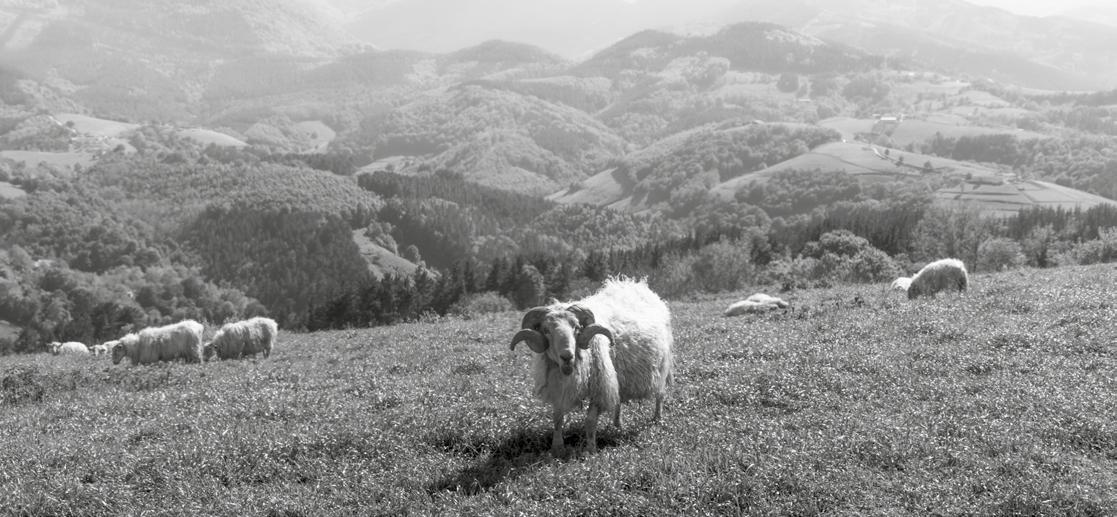
Birdwatching.
Discover all the birdwatching centres in the Basque Country.
www.turismo.euskadi.eus
A wide variety of natural resources for ecotourism, cycling, and hiking.
Bike routes.
From greenways with minimal incline, dotted with tourist and cultural sites, to urban routes in Bilbao, San Sebastián, and Vitoria-Gasteiz, or major routes across the Basque Country, as well as BTT centres. www.turismo.euskadi.eus
Ignatian Way.
Recreates the journey taken by Ignatius of Loyola from his birthplace in 1552. Offers an immersive experience not only for travel but also for personal development and introspection. The full route is 675 km, with 150 km passing through the Basque Country.
www.turismo.euskadi.eus
Camino de Santiago.
Camino de Santiago along the coast and Camino de Santiago inland.
www.turismo.euskadi.eus
Holy Week. Balmaseda.
During Holy Week, the final episodes of Jesus Christ’s life are reenacted.
www.viacrucisbalmaseda.com
Tolosa Carnival. 27 February - 4 March.
The most popular and multitudinous carnivals in the Basque Country are, without a shadow of a doubt, those held in Tolosa.
www.tolosaldea.eus
Zegama-Aizkorri mountain marathon. 25 May.
A medium-mountain route through the Aratz massif and the Aizkorri range, including four of the highest peaks in the Basque Autonomous Community.
www.zegama-aizkorri.com
Ehunmilak in Beasain. 11-13 July.
An ultra-trail® mountain race of 171 km and 10,500 metres of accumulated elevation, crossing the mountains of 5 regions.
www.ehunmilak.com
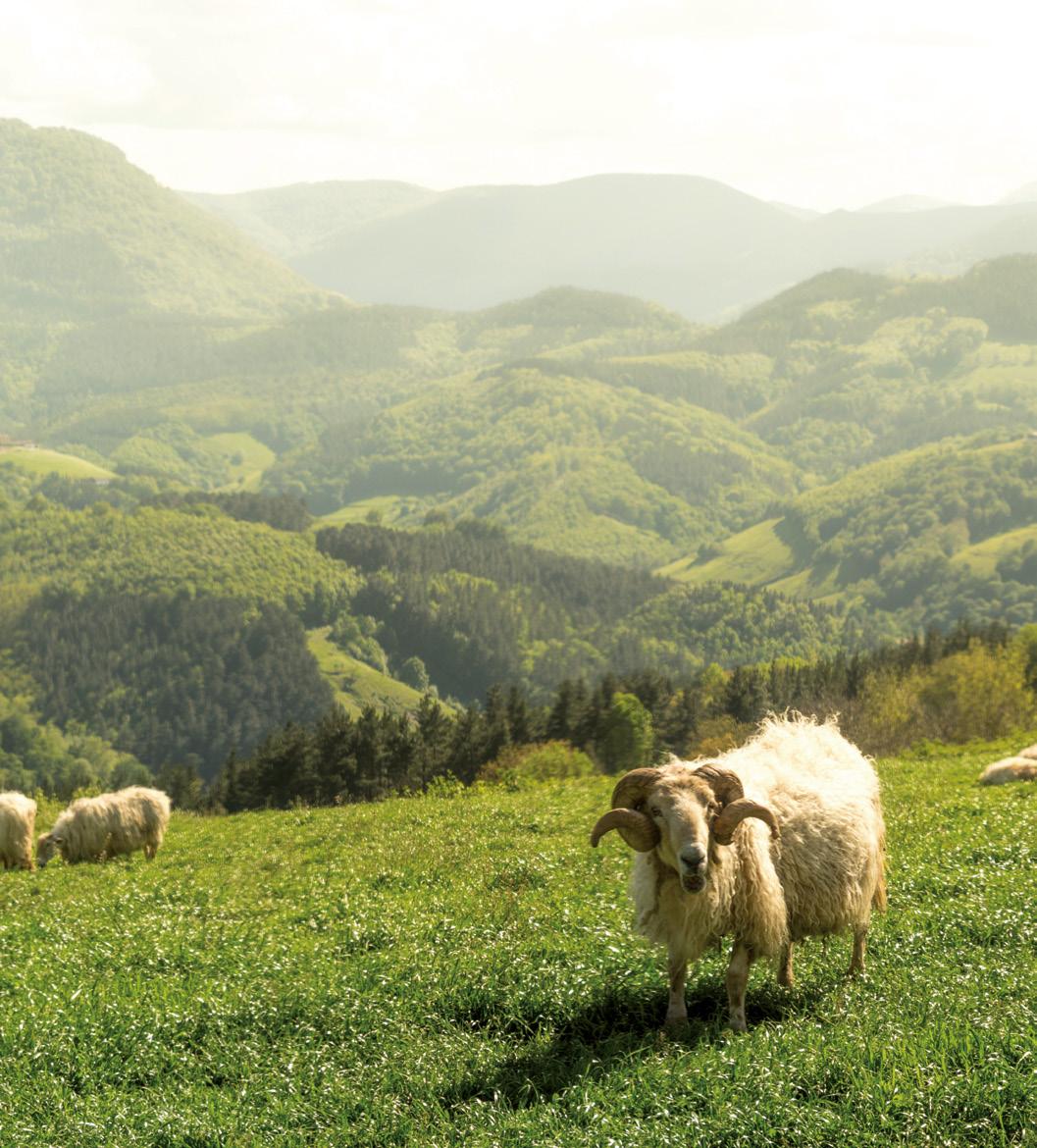
Hiru haundiak. Mountain endurance race. 11 October.
A long-distance mountain race: Gorbeia, Anboto and Aizkorri. 101 km.
www.hiruhaundiak.com
San Blas Fair. Abadiño. 3 February.
A gastronomic and local products fair, one of the oldest and most popular. www.turismo.euskadi.eus
Basque Cheese Fair. 3-4 May.
In Idiazabal, shepherds, sheep, and cheese take centre stage during this weekend fair. www.goierriturismo.com
Last Monday of Gernika. 27 October.
Held on the last Monday of October, it’s the most important agricultural fair in the Basque Country. It’s also a highly festive day, attracting thousands of people each year.
www.azoka.bbk.eus
In Tolosa: Tolosa Bean Festival. 15 November. Over several days, Tolosa pays tribute to one of its most characteristic products: the bean. www.tolosaldea.eus
Haragi. 15-18 May.
International Meat and Grill Meeting in Tolosa. www.tolosaldea.eus
Santa Lucía Fair. 13 December.
In Zumarraga and Urretxu, one of the most important fairs in Gipuzkoa is organised to mark the feast of Santa Lucía. www.goierriturismo.com
Medieval Markets.
In Artziniega, Balmaseda, and Ordizia, once a year, the typical atmosphere of medieval markets is recreated, with exhibitors dressed in period attire.
In Artziniega, in September. In Balmaseda and in Ordizia, in May.
www.alavaturismo.eus
www.balmaseda.eus
www.goierriturismo.com
Alava Txakoli Festival. Amurrio. 25 May. Fair guide.
Gatz Eguna. Leintz Gatzaga. 11 May. Fair guide.
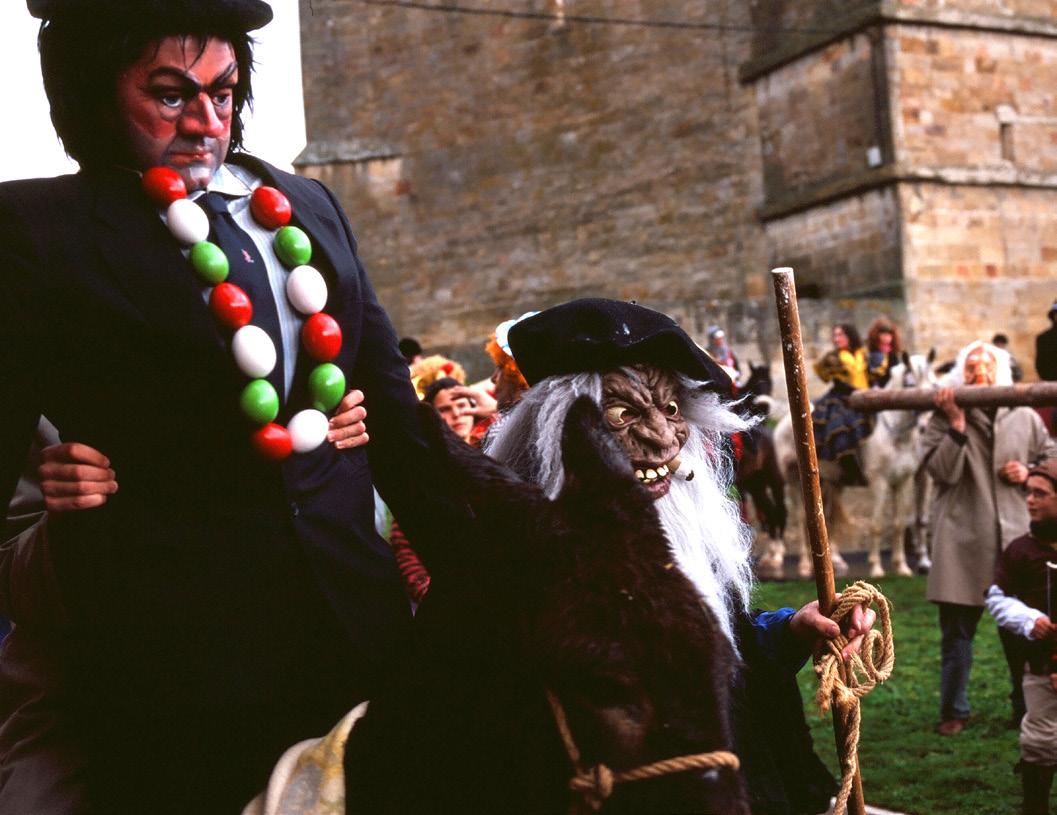
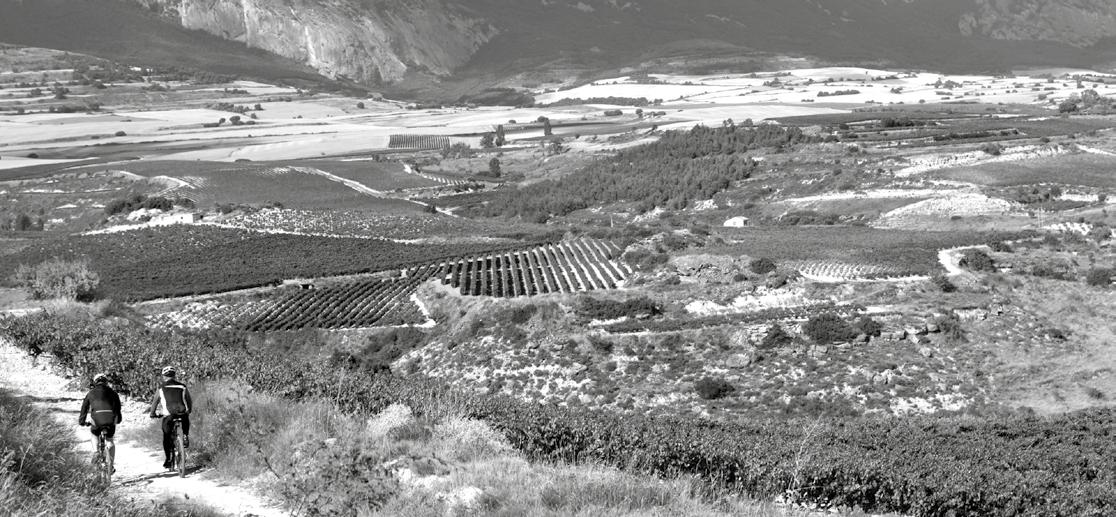
Grape Harvest Festival. Leza. 14 September. The Grape Harvest Festival is celebrated just before the start of the grape harvest in Rioja Alavesa. This large-scale, itinerant celebration began in 1994 in the town of Laguardia and has since toured the entire region to showcase its municipalities, way of life, and wine as an economic driver and cultural value. www.fiestadelavendimiariojaalavesa.com www.rutadelvinoderiojaalavesa.com
The enobus.
Forget the car and trust the guides of this tourist bus, which will allow you to visit two of the regions with the greatest winemaking tradition in the Basque Country: Rioja Alavesa in Álava and Uribe in Bizkaia: Two regions and two completely different wines: the extraordinary reds of Rioja Alavesa and the quintessential white wine of the Basque Country, the txakoli of the Uribe region, near Bilbao. Two regions and two options to choose from, ensuring an unforgettable day. www.turismo.euskadi.eus
Rioja Alavesa Wine Run. Laguardia. 26 October. Race through the vineyards. www.riojaalavesawinerun.com
Esférica Rioja Alavesa. August.
Esférica Rioja Alavesa offers a complete experience combining live music and gastronomy in several luxury locations in Álava, including Laguardia, Lapuebla de Labarca, Labastida, and Elciego. www.esfericariojaalavesa.com
La Puebla de Labarca. Uztaberri Eguna. 8 February.
A day dominated by a passion for the fine wines of Rioja Alavesa. Around twenty local wineries open their doors to visitors, who have the opportunity to taste the latest vintage first-hand.
The Uztaberri Eguna also brings a host of activities closely linked to rural life and viticulture. www.turismo.euskadi.eus
Orbea Gravel Rioja Alavesa. 24-25 October.
A unique experience in Rioja Alavesa, known for its exceptional wines and stunning landscapes. This multi-day event brings together gravel enthusiasts from around the world to explore the perfect combination of nature, culture, and cycling passion. www.orbea.com


Basque Coast Museum Network.
Brings together museums, interpretation centres, and other facilities with different focuses but a central theme: the coast.
www.losmuseosdelacostavasca.com
The Mutriku-Deba-Zumaia Flysch Route.
Designated a UNESCO Global Geopark. The towns of Mutriku, Deba, and Zumaia allow visitors to explore the hard and soft rock strata that form the flysch, a natural layer cake. www.geoparkea.com
Camino de Santiago.
Camino de Santiago along the coast and Camino de Santiago inland. www.turismo.euskadi.eus
Trainera Championship Races. The rivalries of fishing leisure turned into a tough and spectacular sport. Trainera regattas are held every weekend in July, August, and September. www.euskolabelliga.com

Jai Alai Winter Series Final in Gernika. 16 February.
Jai Alai World Tour. Hondarribia. July.
www.deplanesporlacomarca.com
Mundaka celebrates its Aratusteak on 2 March with lively parades of Atorrak and Lamiak.
Other notable summer festivals include San Pedro (29 July) in many coastal towns, Goose Day in Lekeitio (5 September), Cármenes in Santurtzi (16 July), Madalenas in Bermeo-Mundaka-Elantxobe (22 July), and the Zapato Azule (Blue Shoe) festival in Ondarroa (28 June).
Traditional cultural events include the Irun Parades (30 June) and Hondarribia (8 September), Kutxa Eguna (Kutxa Day) in Hondarribia (25 July), the recreation of an old Basque wedding in Lekeitio (July), and the Euskal Jaiak (Basque Festivals) in Zarautz (9 September).
www.turismo.euskadi.eus
Numerous gastronomic events are held on the Basque Coast, including:
Txakoli Day in Getaria. 20 January.
San José Fair and Txakoli Harvest Presentation in Bakio. 19 March.
Mackerel Day in Mutriku. 6 April.
Anchovy Day (Antxoa Eguna) in Getaria. 2-4 May. And in Ondarroa, on 17 May.
Fish Fair (Arrain azoka) in Bermeo. 16-18 May.
Sea Bream Festival in Orio. July.
Octopus Day in Zumaia. 20 September. Fair guide.
Getxo Folk International Folk Festival. 10-14 September.
www.getxo.eus
Bidasoa Folk Jaialdia/Festival Bidasoa Folk. Hondarribia-Irun-Hendaia. 22-24 August. www.irunhondarribiahendaye.com
The Basque Country, while diverse in its landscapes, generally enjoys a mild climate. However, temperatures have risen above average norms in recent years. In 2022, coastal areas experienced average temperatures of 16-17°C, while inland regions recorded 13-15°C, marking an approximate increase of 1.8°C.
(AS OF 1 JANUARY 2024)
· Euskadi: 2,208,007 inhabitants.
· Vitoria-Gasteiz: 251,974 inhabitants.
· Bilbao: 344,408 inhabitants.
· Donostia/San Sebastián: 182,892 inhabitants.
Source: Population and housing census. Population structure as of 30 October 2024, Eustat.
· Crime rate (number of criminal offences per 1,000 inhabitants) (2023): 48.5, lower than Spain’s national average of 50.9.
Source: INE based on data from the Crime Statistics Portal. Ministry of the Interior.
· GDP per capita (2023): 42,058 €.
Source: Eustat Economic Accounts, 5 December 2024.
· GDP per capita in Purchasing Power Parity (PPP) (2022): 108 (UE27=100), 8% above the EU27 average.
Source: Eustat and Eurostat Economic Accounts. 10 October 2023.
· Distribution of GDP by sector of economic sectors (Q3 2024):
· Agriculture, livestock, and fishing: 0.8%
· Construction: 4.9%
· Industry and energy: 21%
· Services: 64.2%
· Tourism: 6.6% (2023)
Source: Eustat Economic Accounts and Tourism Satellite Account.
· R&D expenditure (% of GDP) (2023): : 2.16 %.
EU27 average (2022): 2.27%, Spain average (2023): 1.49%.
Source: Eustat Statistics on Scientific Research and Technological Development Activities.

· Human Development Index (HDI) (2023).
The Basque Country ranks among the top 18 countries globally in this indicator.
Source: Eustat. Human Development Index. 27 March 2024.
The Human Development Index (HDI) is a powerful measure that captures the essence of human progress. It reflects the average achievements in three key pillars of development: living a long and healthy life, acquiring knowledge, and enjoying a decent standard of living. The HDI is calculated as the geometric mean of normalised indices for each of these dimensions, offering a holistic view of human well-being. In the Basque Country, the HDI is meticulously crafted using the methodology established by the United Nations Development Programme (UNDP).
Hotel Sector Highlights (2024).
Source: Eustat. Survey of inbound tourism establishments. 24 January 2025.
Camping 2024.
Source: EOAT of the INE. 31 January 2025.
Distribution of markets by source (2024).
· Ranking of issuing markets to the Basque Country, 2024:
Contribution of tourism to the economy of the Basque Country. Thousands of euros and as a percentage of GDP at market prices. Current prices 2010-2023.
Arrival in the Basque Country (2023).
Primary means of transport used by tourists to reach the Basque Country, 2023.
Source: Eustat’s Inbound Tourism Establishments Survey (ETR) and INE’s EOAT (31/01/2025).
Source: Eustat. Tourism Satellite Account, 30 December 2024.
Source: Official statistics operation “Ibiltur 2023: Profile and Behaviour of Tourists Staying in Regulated Accommodation in the Basque Country for Leisure Purposes”. Basquetour.
Retention and recommendation rate (2023).
· 37% of tourists who have visited the Basque Country will return within the next 12 months, with an additional 28% likely to do so.
· 88% of tourists travelling to the Basque Country would recommend it as a holiday destination to their family and friends, with a further 10% likely to do so.
Source: Official statistics operation “Ibiltur 2023: Profile and Behaviour of Tourists Staying in Regulated Accommodation in the Basque Country for Leisure Purposes”. Basquetour.
Residents Perceptions of Tourism Activity in the Basque Country (2024).
· 51% of residents state that the tourism sector is a very important element of economic development and employment for the Basque Country (down from 66% in 2023).
· 53% of residents say that tourism activity in the Basque Country has a positive impact on their daily lives (down from 75% in 2023).
Source: Official statistics operation “Tourism Habits and Perceptions of Inbound Tourism, 2024”. Basquetour.
8,680 tourist establishments.
86,975 beds/day.
Hotels (2024).
Total number of establishments: 700.
Total daily available beds: 35,913.
Source: Basque Government’s Department of Tourism, Trade, and Consumption – Tourism Business and Activity Registry (REATE), data as of 14 February 2025.
Rural Accommodation (Agrotourism and Rural Houses) (2024).
Total number of rural accommodations: 464.
Total daily available beds: 5,088.
Source: Basque Government’s Department of Tourism, Trade, and Consumption – Tourism Business and Activity Registry (REATE), data as of 14 February 2025.
Tourist Apartments (2024).
Total number of tourist apartments (accommodation units): 1,782.
Total daily available beds: 5,893.
Source: Eustat Survey of Tourist Apartments (ETRap). January 2025. Basque Government’s Department of Tourism, Trade, and Consumption – Tourism Business and Activity Registry (REATE), data as of 14 February 2025.
Tourist Hostels (2024).
Total number of tourist hostels: 80.
Total daily available rooms: 690.
Total daily available beds: 3,906.
Basque Government’s Department of Tourism, Trade, and Consumption – Tourism Business and Activity Registry (REATE), data as of 14 February 2025.
Campsites (2024).
Total number of campsites: 27.
Total daily available pitches: 2,592.
Total daily available beds: 11,421.
Source: Basque Government’s Department of Tourism, Trade, and Consumption – Tourism Business and Activity Registry (REATE), data as of 14 February 2025.
Holiday rentals (2024).
Total number of holiday rental properties: 4,864
Total daily available beds: 21,778.
Source: Basque Government’s Department of Tourism, Trade, and Consumption – Tourism Business and Activity Registry (REATE), data as of 14 February 2025.
Holiday rental rooms (2024).
Total daily available rooms: 763.
Total daily available beds: 2,976.
Source: Basque Government’s Department of Tourism, Trade, and Consumption – Tourism Business and Activity Registry (REATE), data as of 14 February 2025.

The Basque Country is divided into three historical territories: Álava, Bizkaia and Gipuzkoa, with their capitals: Vitoria- Gasteiz, the capital of Álava; Bilbao, the capital of Bizkaia and Donostia-San Sebastian, the capital of Gipuzkoa.
This Autonomous Community has two official languages: Basque and Spanish.
The Basque Country enjoys a high level of selfgovernment in such important areas as health, education, security, housing or tax. This autonomy to decide its own organisation derives from the Statute of Gernika which was passed by referendum on 25th October 1979, recognising the existence of a Government with executive powers and a Parliament with general legislative capacity.
Furthermore, the Basque Country has two territorial bodies inherited from Basque foral tradition, the General Assemblies, with regulatory and functional powers similar to those of parliaments; and the Provincial Councils, their executive institutions. Their existence makes the Autonomous Community extremely decentralised, almost a confederation.
The method of harmonising the powers of the state administrations with the provincial ones is regulated by the Statute of Autonomy and by the Law on Historical Territories, which adjusts the existence of a general organisation with respect to the historical legal systems of the three territories.
Another fundamental pillar of Basque selfgovernment is the ‘Economic Agreement’, the financial regulation of the Autonomous Community which allows Basque institutions to collect and manage taxes from citizens in accordance with its own budgets and agreements entered into with the Spanish State Administration.
All of these measures have enabled the creation of its own organisations, such as Euskal Irrati TelebistaETB, the Basque public media group; the Ertzaintza, the autonomous police force with over 7,000 agents, and it has full powers in road and hydraulic infrastructures, economic and industrial development and in regional planning.
Nowadays, powers in terms of work and employment, industry, infrastructures, finance and research are pending transfer from the State Administration.
There are two official languages in Euskadi: Basque and Spanish.
Basque or “the Basque language” is the oldest living language in Europe and it is spoken on both sides of the Pyrenees.
International Airport of Bilbao:
· 13 km from the centre of Bilbao.
· 76 km from Vitoria-Gasteiz.
· 101 km from Donostia/San Sebastian.
Airport of Donostia/San Sebastián:
Just 20 minutes from the centre of the city, this airport connects with the major Spanish cities of Madrid and Barcelona.
Airport of Vitoria-Gasteiz: 9 km from the city.

Nueva York (starting 31 May 2025)




































Note: Air connections to Basque airports as of February 2025.




